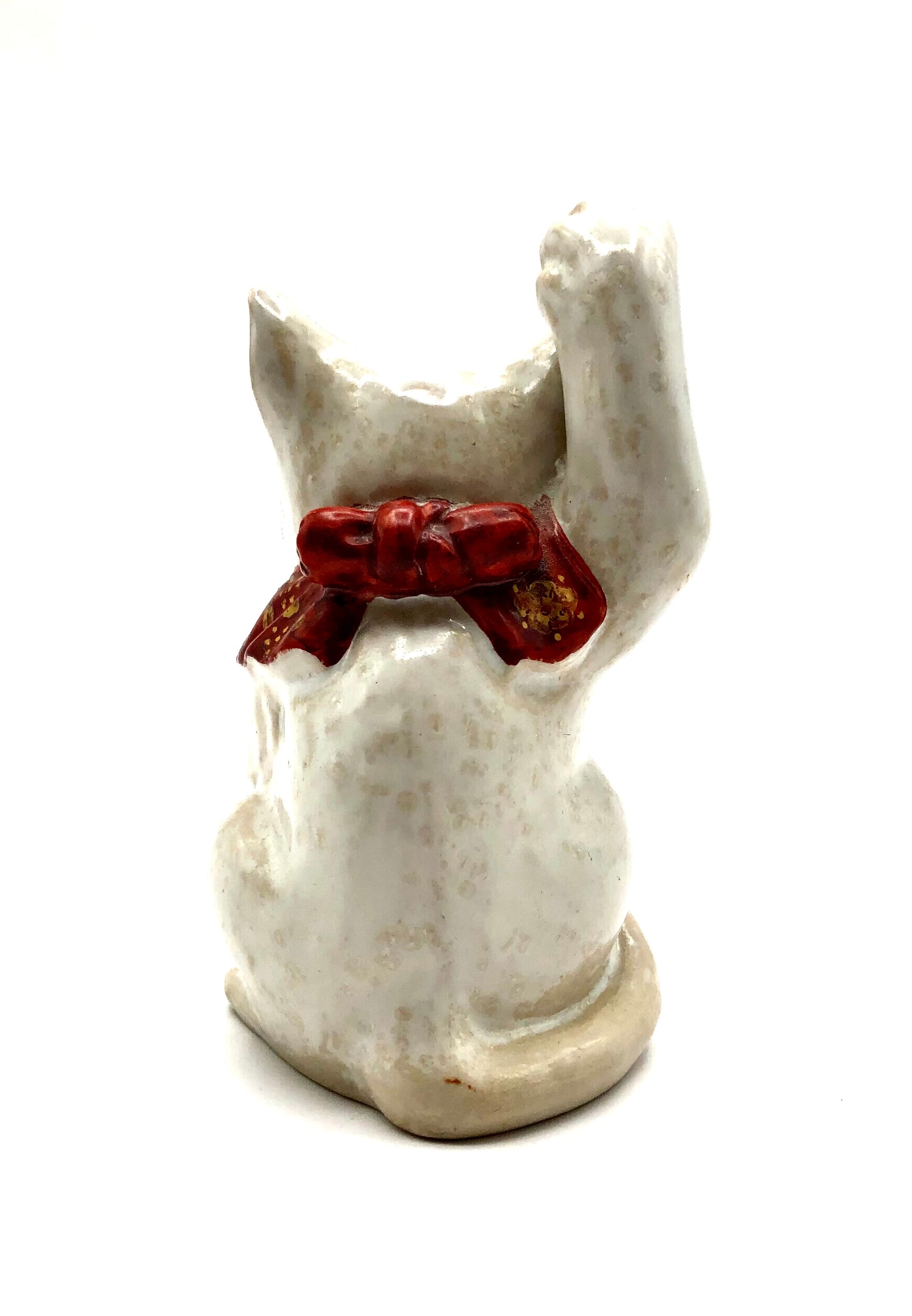





Vintage Japanese Kutani Porcelain Maneki Neko, (Lucky Cat) | “Inviting Neko” by Miyamoto, Naoki
Dimensions: 5-0”h x 2-1/2” dia.
To introduce this Kutani/Mino creation we begin by discussing the Kiln, where the artist worked, with a handful of other artists, making a range of creative objects. This piece was produced at the Kozo Kiln. The founder, Kato Kozo, resurrected 16th-century techniques with the help of a handful of contemporary Mino potters. The Kiln established its reputation for creating Shino and Setoguro wares and some small commissioned pieces. Miyamoto, Naoki, (1934-2012) worked as one of the establishing associates/apprentices at Kozo kiln, under the direction of Kato-san.
This white Kutani Porcelain Calico, “Matekineko”, is still in production, for this piece is the original prototype that was customized for a client and created by artist, Miyamoto, Naoki. He was a respected and accomplished artist, sensitive to materials and techniques that utilized rich glazes accented with color detailing. This Maneki Neko was named at the time: “Inviting Neko”, which became a charming and iconic Japanese figurine. Contemporary versions continue to be produced as a symbol of prosperity, and success. According to the auction house where this piece was purchased, this popular talisman was specifically made for a retired Oiran, “Mira no totoro no nest”, who operated a pleasure house in the Kazue-machi district. This unknown Oiran presided over a salon for elegant and intimate pleasures with the courtesans and geisha, and she also coordinated with owners of district teahouses that introduced high-ranking customers, (including actors, musicians, artists, samurai, sumo, and high-ranking officials), to these establishments.
So this is the background where this little Neko found its home. This “one-off” Neko is wearing a distinguished red muffler/scarf decorated with a ceramic bell, with gold flowers and symbols. His raised paw is one of two key features. Its position holds specific meanings: Firstly, its’ right paw is up, to invite money and good fortune, which was necessary in its previous owner’s enterprise. Secondly, calico cats are usually female and few are male, so it is unusual to see Maneki Neko as male with these details, particularly when you turn the figure over and see that the artist has added male genitalia, (not styled after a cat’s private parts, but human). It was not unusual for wealthy and educated Geisha to be as fashionable as the aristocratic people they served. Many surrounded themselves with artwork such as woodblock prints, (see the images associated with this research, such as this hanging scroll entitled: Courtesan plucking Bodhidharma/Daruma’s beard, by Inoue Setsuzan, reflecting on Daruma's nine years of meditation, and a Geisha’s ten years of trial-laden life at a brothel). Such accumulated erotic art objects like this Maneki Neko were collected by women in this industry beginning in the Early 19th century in Japan.
As shown in the images, one can see that the piece was modified to suit a courtesan’s goals, being a successful business person, enjoying prosperity, and overall success. As noted, this RARE and UNUSUAL little figurine shows a personal/customized, mark and signature of the artist, Miyamoto, Naoki. He exhibited a high level of technology in fabricating, finishing, and detailing this charming cat. (NOTE: the information contained herein was compiled from the provenance received at the time of purchase.) The images are not part of this sale but support the research and provenance.
Condition: Superb, unique, displaying a beautiful fabrication. It is void of chips, cracks, breaks, missing pieces, or restoration, and retains its original details and finish. With its wonderful presence, it was protected and treasured by the previous owner.
